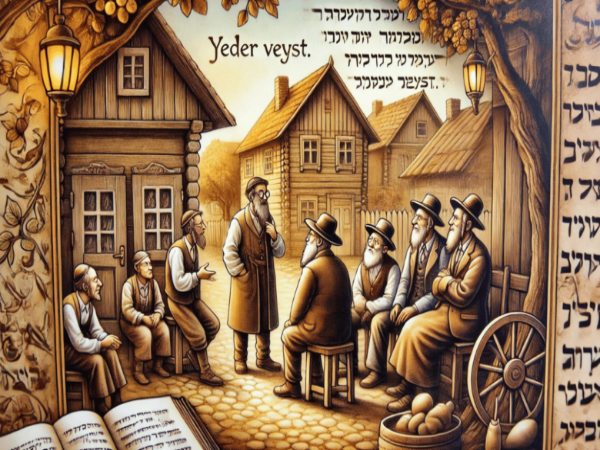Yeder Veyst: The Timeless Power of Collective Understanding
Unlocking the Meaning, Origin, and Cultural Depth of a Yiddish Classic

Yeder Veyst” is a Yiddish phrase that literally translates to “everyone knows” or “everybody knows” in English. It is a powerful expression of collective understanding, often used to convey truths that are universally accepted within a community. Whether in daily conversation, storytelling, or cultural references, the phrase serves as a shorthand for shared wisdom or common knowledge that transcends explanation.
Introduction
Language is more than just a tool for communication—it’s a vessel for culture, history, and collective identity. The Yiddish phrase “Yeder Veyst” embodies this truth perfectly. Rooted deeply in Eastern European Jewish tradition, this seemingly simple phrase carries layers of meaning, tradition, and emotion. From its literal translation to its cultural significance, “Yeder Veyst” is more than words—it’s a reflection of how communities share knowledge, values, and a sense of belonging.
Yeder Veyst Meaning
The phrase “Yeder Veyst” breaks down into two words:
Yeder: meaning “everyone” or “each one.”
Veyst: a form of the verb “visn,” meaning “to know.”
Together, they form a statement of universal knowledge: “Everyone knows.” But the meaning goes far beyond its literal definition. In cultural contexts, it’s often used to signal that something is common knowledge or that further explanation is unnecessary because the truth of the matter is so widely accepted.
Yeder Veyst in English
In English, the phrase “Yeder Veyst” can be most accurately translated as “everyone knows” or “everybody knows.” However, unlike the English equivalents, which can sometimes come off as dismissive or vague, “Yeder Veyst” in Yiddish carries emotional and cultural weight. It often implies a shared understanding within a tight-knit community—where traditions, values, and lived experiences are passed down across generations.
For example, if someone says, “Yeder veyst that Bubbe’s kugel is the best,” it’s not just about the dish—it’s a nod to heritage, taste, and shared family lore.
Yeder Veyst Translation: A Linguistic Breakdown
To appreciate the beauty of “Yeder Veyst,” it’s helpful to delve into its linguistic structure:
Yeder: Derived from the German word “jeder,” meaning “each” or “every.” Yiddish, a High German-derived language fused with Hebrew, Aramaic, Slavic languages, and more, often mirrors German vocabulary.
Veyst: Comes from the Yiddish verb “visn” (to know), akin to the German verb “wissen.”
So while “Yeder Veyst” translates cleanly into English, its Yiddish roots give it a distinctive flair and depth. The use of the phrase in spoken language often carries a tone of affirmation, agreement, or even gentle sarcasm—depending on the context.
Yeder Veyst Meaning and Origin
Yiddish originated among Ashkenazi Jews in Central and Eastern Europe around the 9th century. The phrase “Yeder Veyst” has likely been in use for centuries, passed down through oral tradition, folk tales, and communal storytelling.
Its origin lies in a culture where much of the wisdom was passed orally, and shared phrases like “Yeder Veyst” played a significant role in preserving communal truths. In shtetls (small towns with large Jewish populations), sayings like these were part of daily speech, bonding people through shared meaning and understanding.
“Yeder Veyst” might have been said with a knowing smile, a sigh of resignation, or a chuckle—all depending on context. It is as much an emotional expression as a factual one.
Cultural Significance of Yeder Veyst
Yiddish is often referred to as a “language of the heart,” and “Yeder Veyst” is a perfect example of this emotional richness. The phrase encapsulates a communal sense of what is known, expected, or inevitable. It has appeared in:
Folk tales: Often used by narrators to establish shared knowledge among listeners.
Comedy routines: Used for punchlines or setups where the joke relies on a common cultural reference.
Modern media: Occasionally pops up in films, plays, and books that reference Yiddish culture or Jewish heritage.
The endurance of such phrases is a testament to their emotional resonance and relevance.
The Phrase in Contemporary Use
Though Yiddish is not as widely spoken as it once was, many phrases like “Yeder Veyst” survive in modern Jewish and secular conversation. Especially in Jewish communities in New York, London, and Israel, Yiddish phrases pepper everyday language.
“Yeder Veyst” continues to be used to:
Emphasize a point
Highlight an obvious truth
Underscore cultural knowledge or shared assumptions
Its usage isn’t confined to religious or traditional settings. Even younger generations use such expressions to connect with their roots or add color to modern speech.
Why Phrases Like Yeder Veyst Matter
In an age of rapid globalization and cultural blending, maintaining linguistic and cultural identity is more important than ever. Expressions like “Yeder Veyst” are not just quaint linguistic relics—they are living pieces of cultural DNA.
They remind us of:
- Where we come from
- What binds us together
- The value of shared understanding
Preserving and celebrating these phrases helps keep the richness of Yiddish culture alive, even as languages evolve.
Teaching and Learning Yiddish Phrases
Learning phrases like “Yeder Veyst” can be an enriching experience for those interested in Jewish culture, linguistics, or history. Many educational programs, from online courses to community center classes, offer insights into Yiddish language and heritage.
Incorporating such phrases into your vocabulary:
Honors tradition
Adds emotional and cultural depth to communication
Connects you with generations past
Even if you’re not fluent in the language, embracing expressions from Yiddish can foster a strong sense of cultural connection and belonging.
Conclusion: The Enduring Relevance of Yiddish Expressions
Phrases like “Yeder Veyst” are more than mere words—they’re doorways into a rich cultural tapestry. From their linguistic roots to emotional resonance, these expressions capture the essence of shared knowledge and collective wisdom. In a world where communication is often rushed and impersonal, these treasured sayings remind us of the power of language to unite, affirm, and preserve.
So next time you hear a phrase that feels familiar yet profound, smile—because you just might understand something timeless and deeply rooted in shared human experience.



